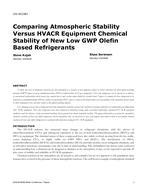Description
A whole new class of refrigerant chemistry has been developed as a reaction to new regulatory actions to restrict and lower the direct global warming potential (GWP) impact of many hydrofluorocarbons (HFC) or fluorocarbon (or F-gas) refrigerants. These new refrigerants can be referred to as alkenes, or unsaturated hydrocarbons which means they contain two or more carbon atoms linked by a double bond. Today it is common for these refrigerants to be referred to as hydrofluoroolefins (HFOs), olefins or unsaturated HFCs and as a result of the double bond, can react quickly in the atmosphere which results in short atmospheric lives and thus results in low global warming impacts.
It is confusing to many that a refrigerant with high atmospheric reactivity can have low reactivity in heating ventilation air conditioning and refrigeration (HVACR) equipment. These new refrigerants have been evaluated in laboratory testing under accelerated temperature simulated HVACR equipment conditions and have shown a variety of chemical reactions, but in general have shown acceptable stability. This paper will provide an overview the atmospheric chemistry reactions of these new olefin refrigerants, which atmospheric lives are measured in days, and compare and contrast them to very limited chemical reactions for these new olefin refrigerants in accelerated life laboratory testing for HVACR equipment.
Citation: 2018 Winter Conference, Chicago, IL, Conference Papers
Product Details
- Published:
- 2018
- Number of Pages:
- 8
- Units of Measure:
- Dual
- File Size:
- 1 file , 2.1 MB
- Product Code(s):
- D-CH-18-C061




